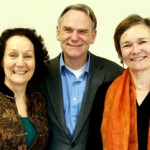
Narrative Practices Adelaide
Who is this “Michael White” Fellow? Maggie, Shona and Rob – as Michael’s close colleagues – reviewed their work at Narrative Practices Adelaide since Michael’s death, with their understanding of Michael’s intentions in mind. In this audio recording, they describe several experiences that reassure them that narrative ideas and practices are having a life of their own even for people who never knew Michael. They reflect on how they aspire to bring Michael’s presence into their teaching – the ethical position of the work, the careful, thoughtful way Michael spoke. As Rob says, “Behind the practice of narrative is such a strong, powerful and helpful ethic in terms our engagement with people, what people mean to us, and what we can all mean to each other.”
The ideas and practices are having a life of their own
Transcript
Maggie, Shona and Rob speak about their experiences of bringing Michael’s presence into teaching
Maggie: I’ve also been thinking about what you said about doing one week and two-week intensives. This is continuing a tradition of Michael’s. He had a number of them each year. I was just thinking about one we did last year, Shona where there were people from Adelaide as well as other parts of Australia. We were establishing the group early on in terms of context that people can ask any questions, there is no question that isn’t worthwhile to be asking because we were going to have a whole week together. We introduced ourselves as offering the work of Michael White, referring to the ways in which he spoke about narrative practice. At the end of this little introduction, one young man put up His hand and said, “This might be a stupid question but you said it’s okay to ask any questions. Who is this Michael White fellow?”
That was just lovely for us to be in that situation where there is still a growing interest in narrative practice; it’s not relying on Michael being there to do these intensives. The ideas and practices are having a life of their own that is being recognized, people are drawn to that, without having known Michael.
It is also precious to hear where people have had to chance to have known Michael. I was teaching in another course that we are all involved in here in Adelaide, an ongoing NPA two-year diploma course with Aboriginal health workers in using a narrative approach. I was showing some video the other day where we were looking at community practice of the first gathering that Michael facilitated with a counseling team with an outsider witness listening group. In that, there’s a little bit of Michael describing the listening group, what’s the listening group is there for in terms of hearing people stories and having a chance to retell them. This was a practice that we were exploring in that group. One of the things that people said afterwards was how lovely it was to actually see Michael and to have a sense of this person. That’s been really lovely to have those re-connections especially at this time where it’s been three years, to have those opportunities to hear the sound of his voice and the careful, thoughtful way he spoke.
Shona: I think you’re speaking about something really important, Maggie that is how we can bring Michael’s presence into teaching. I share with you this interest. I had an experience in February this year, two months ago, where I asked people, “How many have had a chance to meet Michael?” Nobody put up their hand. “How many people have had the chance to be in a workshop with Michael?” Nobody put up their hand. “How many people had a chance to attend a conference where Michael shared a part?” Nobody put up their hand. So the point that you’re raising is so important about how to bring Michael’s presence into the teaching. What gets demonstrated through his presence is so much about the position of the work, way beyond the technology of the work (17.58). It’s really about the position of the work. It’s an ongoing question for us, a search for interesting and relevant ways of bringing Michael’s presence into teaching.
Maggie: Like you are saying – bringing the spirit of the work in terms of that careful, ethical position.
Rob: …the thoughtfulness, the tenderness, the care and attention that he brought to almost every interaction. Behind the practice of narrative is such a strong, powerful and helpful ethic in terms our engagement with people, what people mean to us, and what we can all mean to each other. It is fundamental that we find ways to bring the spirit behind this work into the training.
Shona: One of the many contributions of the online learning through “Reauthoringteaching.com” has done is to try to make more available notes and recordings from interesting conferences, presentations so people can see and hear Michael’s presence. We’re also trying to figure other creative ways we can bring his presence into our work….
Maggie: that highlight the importance of that ethic, making sure that it is shared in good ways.
